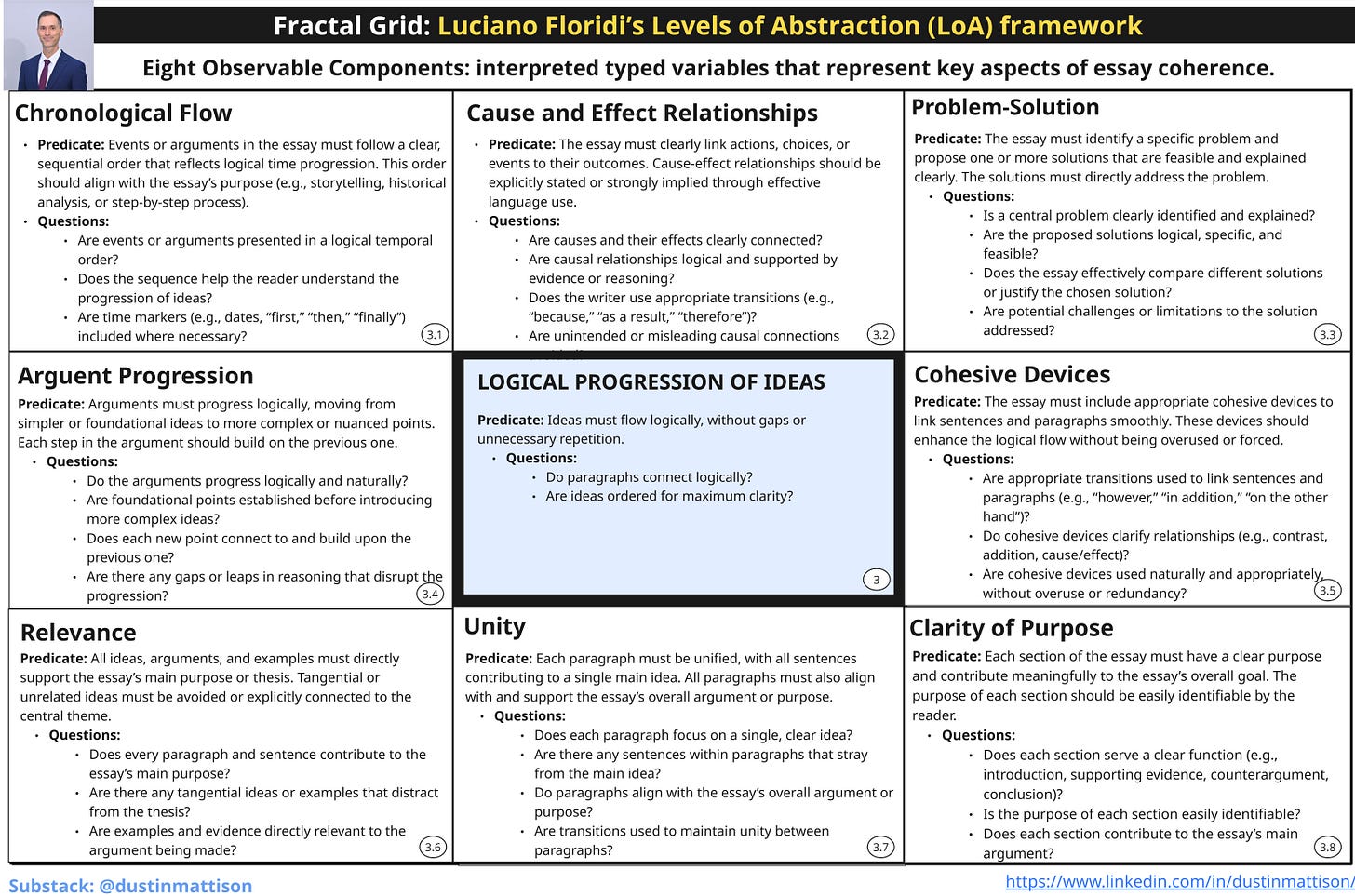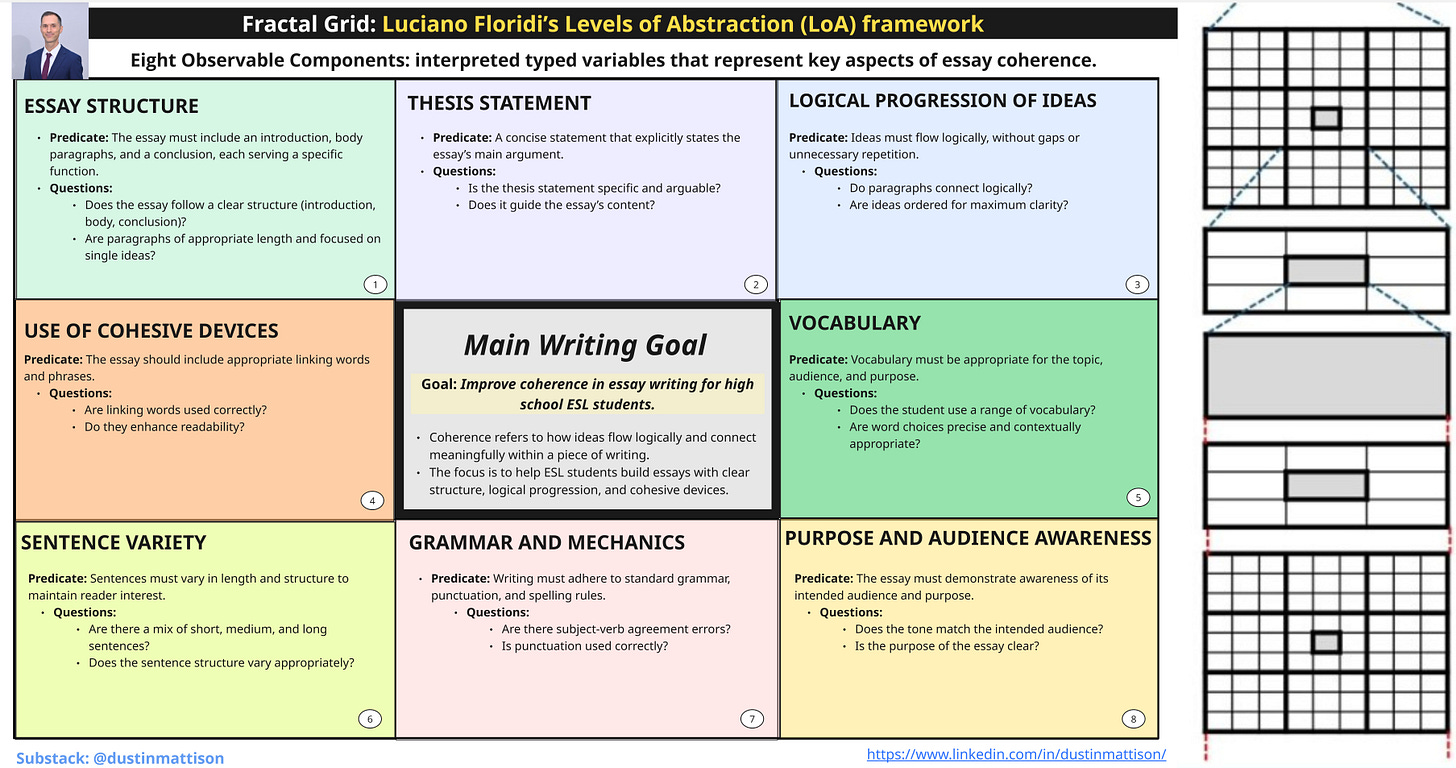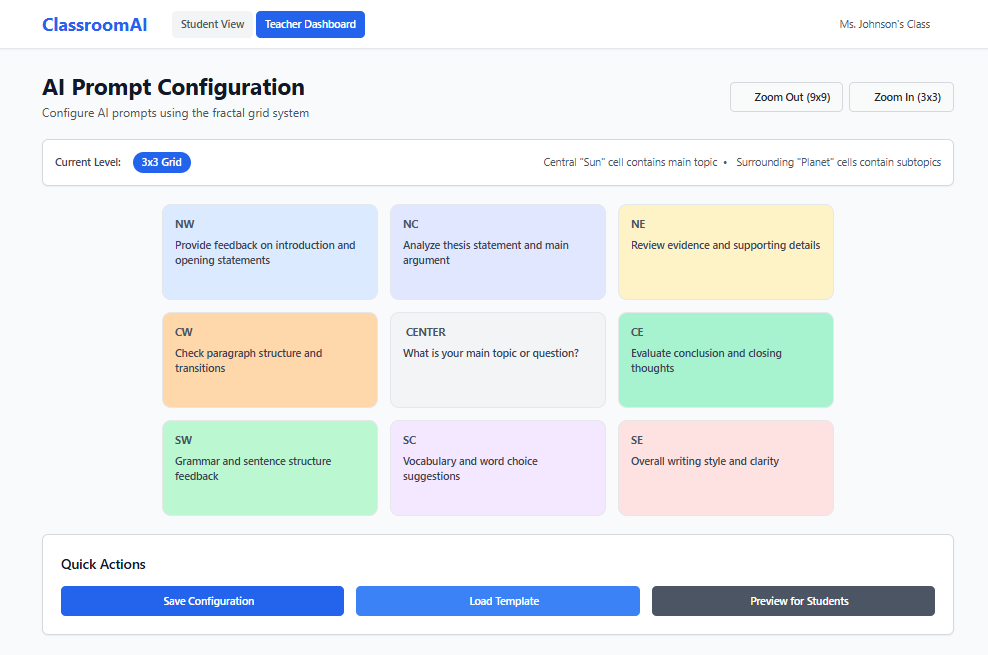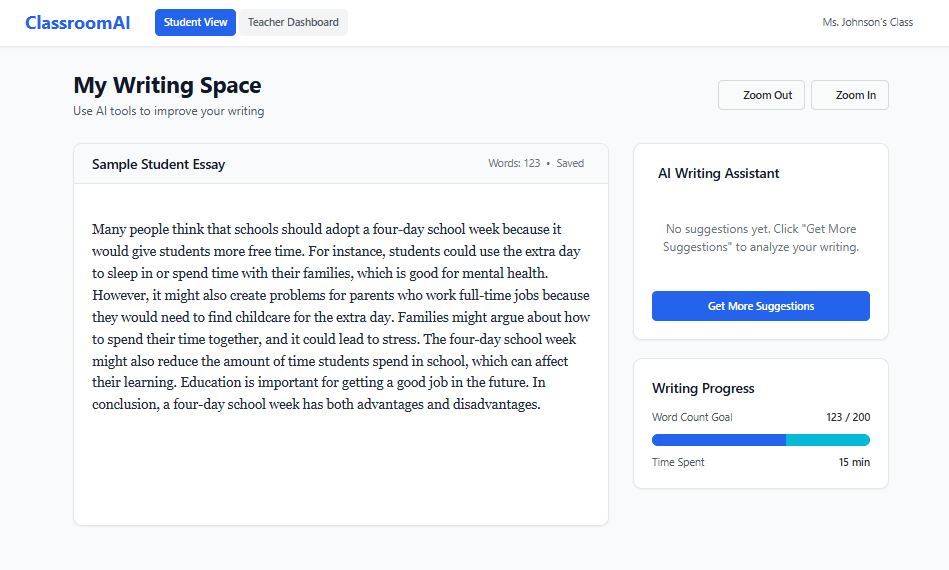Tools for Teaching Writing That AI Can’t Fake
Using LoA and Fractal Gridding to focus on process, not just polish.
AI has turned every essay into a polished surface, like a smooth stone. But writing teachers need an X-ray, a way to see beneath the surface to uncover the inner structure of real learning and thought. How do we assess authentic student learning—the deep thinking, messy revision, and genuine struggle that machines can’t fake?
The answer isn’t another checklist or rubric; it’s a revolution in how we observe and understand learning. Enter two extraordinary tools that, when combined, can reshape the way we teach writing: Luciano Floridi's Levels of Abstraction (LoA) and Fractal Gridding invented by Rod King.
Levels of Abstraction: Precise Tools for Messy Learning
Terry Underwood did a great job of introducing Floridi's Levels of Abstraction (LoA) as a valuable analytical tool for educators to understand complex learning processes, specifically in literacy. Think of Luciano Floridi’s Levels of Abstraction (LoA) as your intellectual scalpel. This framework demands sharp focus by asking: “What exactly are we observing?” LoA challenges us to move beyond vague assessments and define specific observables—measurable features of student work that reveal authentic learning. For example, instead of asking, “Did the student revise the essay?” LoA pushes us to dig deeper: “How did the student strategically revise based on feedback? What does their process reveal about their growth?”
Each observable is carefully constrained by a predicate—a rule that defines when something genuinely counts as evidence of learning. For instance, a "self-correction" only counts if the student first recognizes their mistake, then fixes it independently. No guesswork, no shortcuts—just precise, actionable insights.
LoA transforms teaching into a science of observation, helping us untangle the layers of writing:
- High-level abstraction: Is the essay coherent overall?
- Mid-level abstraction: Do paragraphs connect logically?
- Low-level abstraction: Are events or arguments presented in a logical temporal order?
This clarity ensures we’re assessing real learning processes, not just the polished surface AI can easily mimic.
Fractal Gridding: Your Visual Dashboard for Learning
Now imagine a tool that brings all these precise observations to life—a workspace that’s both endlessly adaptable and visually intuitive. Enter Fractal Gridding, developed by Rod King and applied by educators like Dustin Mattison.
Here is a podcast produced using NotebookLM which dives into two frameworks, Levels of Abstraction (LOA) and Fractal Gridding, as powerful tools for English writing teachers, especially in the age of AI.…
Fractal Gridding starts with a simple 3x3 grid:
- The central “sun” cell holds your main focus (like “Improve coherence in essay writing for high school ESL students.").
- The surrounding “planet” cells break that focus into related components (like “logical progression of ideas” or “essay structure”).
And here’s the the really cool part: you can zoom in or out infinitely. Each planet cell can expand into its own 3x3 grid, allowing you to move from big-picture issues to the smallest details, like analyzing sentence fluency or word choice. This isn’t just a tool for organization—it’s a way to see the interconnectedness of a student’s writing.
- Struggling with coherence at the essay level? Zoom in to explore transitions between paragraphs.
- Curious about weak argumentation? Zoom out to see how the thesis connects to supporting claims.
Fractal Gridding isn’t just about organizing data; it’s about seeing patterns and relationships. It’s a visual philosophy, showing how writing is a dynamic, interconnected process—not a static product.
The Synergy: LoA Meets Fractal Gridding
Here’s where the magic happens: when you combine LoA’s analytical rigor with Fractal Gridding’s visual flexibility, you unlock a revolutionary way to teach writing.
LoA defines what to observe and at what level of abstraction. Fractal Gridding provides the where and how to connect those observations visually. Together, they let you map authentic student learning in ways that AI simply can’t replicate.
For example:
- You start with a Level 1 observable: Does the essay present a clear and logical argument?
- You zoom into a Level 2 observable: Are topic sentences guiding the reader effectively?
- You dive deeper into a Level 3 observable: Are cohesive devices (like “however” or “therefore”) used correctly and naturally?
Meanwhile, the grid shows you how these layers connect. A vague thesis in the sun cell might ripple out to weak transitions or underdeveloped evidence in the surrounding planets. You’re not just grading; you’re diagnosing, supporting, and understanding.
Disjoint Gradients Synopsis
Disjoint gradients focus on separate aspects of writing that do not overlap, representing distinct systems that can be observed and analyzed independently.
Essay Structure vs. Thesis Statement
Focuses on overall organization versus the clarity of the central argument, highlighting that strong structure can exist without a robust thesis, and vice versa.Logical Progression vs. Cohesive Devices
Examines conceptual flow versus surface-level transitions, emphasizing that ideas can flow logically without cohesive devices or appear connected superficially with their misuse.Vocabulary vs. Sentence Variety
Distinguishes between word choice and sentence complexity, showing that sophisticated vocabulary can coexist with repetitive sentence structures or varied sentences with limited vocabulary.Grammar and Mechanics vs. Logical Progression
Differentiates correctness in form from conceptual flow, illustrating that essays can be grammatically perfect yet lack logical coherence or vice versa.Purpose and Audience Awareness vs. Essay Structure
Contrasts engaging tone and relevance with formal organization, demonstrating that essays can address the audience well while being structurally weak or vice versa.Thesis Statement vs. Cohesive Devices
Highlights the central argument versus linguistic connections, showing that a strong thesis can exist without transitions or transitions can appear in essays lacking a clear thesis.Vocabulary vs. Grammar and Mechanics
Separates word choice from correctness in form, explaining that advanced vocabulary may come with errors or correct grammar with imprecise vocabulary.Sentence Variety vs. Purpose and Audience Awareness
Compares sentence diversity with audience engagement, noting that varied structures may ignore tone while audience-specific tone may rely on repetitive sentence patterns.
Nested Gradients
Different from Disjoint Gradients, Nested gradients zoom in with increasing detail on the same phenomenon. This can be seen in the Fractal Grid below where we are zooming in on the Logical Progression of Ideas LoA.

Why This Matters in the AI Era
AI can produce essays that look good, with fluent sentences and decent structure. But what AI can’t do is replicate the messy, human process of learning—revising based on feedback, crafting an original voice, or grappling with complex ideas.
By shifting focus from static products to dynamic processes, LoA and Fractal Gridding help us uncover what’s real. We stop asking, “Is this essay good?” and start asking, “What does this essay reveal about the student’s thinking?”
Revolutionizing Writing Instruction with a Custom App
I have been asking myself, "What if I could bring this synergy to life with custom-designed software built specifically for educators like me?" Even though I am not a coder, I have been making progress with using AI coding assistants to build it! Imagine a tool that combines the analytical rigor of LoA with the visual power of Fractal Gridding, all while keeping teachers like me in full control of how AI is used in the classroom.
Here’s how I envision the app working:
- Teacher Dashboard: Teachers define the LoA prompts relevant to their lesson using an intuitive fractal grid interface. You can zoom in and out to set focus areas, from high-level essay coherence to specific sentence-level mechanics. You enter the prompts for each LoA for the LLM into the cells on the fractal grid. Everything runs on a local server on the teacher's laptop, ensuring privacy and security. All interactions with the AI are logged and stored directly on the teacher’s computer for later analysis and reflection. While I am currently not based in the US, I am also investigating how to integrate FERPA principles to ensure it protects the privacy of student education records.
- Student Dashboard: Students interact with the software during class. With a single click on “Get Suggestions,” the AI identifies the most relevant LoA for the session, narrowing focus to what matters most—no overwhelming smorgasbord of choices. Students are then guided to zoom in and out, exploring the nuances of their writing with precision.
- AI-Powered Support: The AI prompts the student to think critically about their work. For example, if the focus is on logical progression, the AI might ask, “How does this paragraph connect to your thesis? Can you add a transition to make the connection clearer?”
- Revision Tracking: As students revise their work, the software logs their changes, creating a clear record of growth. Teachers can later analyze these revisions to identify patterns, struggles, and breakthroughs.
- Teacher Clarity: The teacher projects a leaderboard at the front of the classroom to show key stats and writing issues common among students in the class. The teacher can also observe key private metrics at their computer. The system will provide alerts to special needs cases which are to be prioritized. The teacher also walks around the classroom and interacts with students.
Why this matters:
This software doesn’t just use AI—it puts teachers in the driver’s seat. I am not just talking theory and big ideas. I am putting the ideas into practice by learning how to design and build a custom app which allows me to define the focus, guide student interactions, and ensure that the AI supports genuine learning rather than replacing it. Students, in turn, are empowered to reflect and revise with purpose, engaging deeply with their writing at the right level of abstraction.
The Future of Writing Instruction
LoA and Fractal Gridding are already powerful tools, but when paired with custom-made software, they become transformative. Together, they shift teaching from static products to dynamic processes, from surface-level assessments to authentic learning journeys.
By applying the principles of LoA and Fractal Gridding in my classroom, I will not just be teaching writing—I'll be revolutionizing how students think, grow, and create. And in an era where AI challenges the very notion of authenticity, this approach ensures that what I'm teaching—and what my students are learning—is unmistakably real.




Very cool
A greatly insightful article, Dustin. I believe that you have a robust conceptual foundation for developing an app that solves the problem of students focusing on a surface learning when using AI for school work. Your approach of integrating Luciano Floridi’s Levels of Abstraction with Fractal Gridding facilitates a deeper approach to student learning especially when using AI for school work.
Your above article is well thought and laid out. I hope that you continue to develop your custom app which I believe with be a game-changer in how students learn in the Age of AI especially in writing assignments. Do keep us posted on your progress.